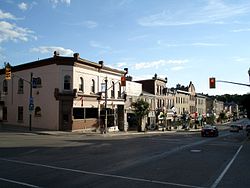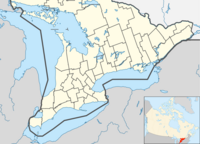St. Mary's, Ontario
| St. Marys | |
|---|---|
| Town (single-tier) | |
| Town of St. Marys | |
 |
|
| Nickname(s): The StoneTown | |
| Motto: The Town Worth Living In | |
| Coordinates: 43°15.5′N 81°08′W / 43.2583°N 81.133°WCoordinates: 43°15.5′N 81°08′W / 43.2583°N 81.133°W | |
| Country |
|
| Province |
|
| Established | 1844 |
| Incorporated | 1864 |
| Government | |
| • Mayor | Al Strathdee |
| Area | |
| • Land | 12.48 km2 (4.82 sq mi) |
| Population (2016) | |
| • Total | 7,265 |
| • Density | 584/km2 (1,510/sq mi) |
| Time zone | EST (UTC-5) |
| • Summer (DST) | EDT (UTC-4) |
| Postal Code | N4X |
| Area code(s) | 519 and 226 |
| Website | townofstmarys.com |
St. Marys is a town in southwestern Ontario, Canada. It is located at the junction of Thames River and Trout Creek, southwest of Stratford, surrounded by the Township of Perth South and located in Perth County, Ontario. However, like Stratford, St. Marys operates under its own municipal government that is independent from the County's government. Nonetheless, the three entities "enjoy a large degree of collaboration and work together to growth the region as a leading location for industry and people". Census data published for Perth County by Statistics Canada includes St. Marys and most Perth County publications also do, at least in some sections of the document.
The town is also known by its nickname, "The Stone Town", due to the abundance of limestone in the surrounding area, giving rise to a large number of limestone buildings and homes throughout the town. St. Marys Cement, a large cement producer founded in the town, capitalized on this close feedstock, and grew to be a major producer of cement in the province of Ontario.
St. Marys is home to the Canadian Baseball Hall of Fame. It is the burial place of Arthur Meighen, Canada's 9th Prime Minister. Timothy Eaton, who went on to become one of Canada's greatest retailers, opened his first businesses in Canada in St. Marys and nearby Kirkton, Ontario.
In 1839 the Canada Company sent a surveyor to Blanshard Township in the Huron Tract to choose a site for a town on the Thames River which would later be named St. Marys.
The first settlers arrived at the junction of the Thames River and Trout Creek, southwest of Stratford in the early 1840s, attracted by the area's natural resources. At the new town site, the Thames River cascaded over a series of limestone ledges, providing the power to run the first pioneer mills and giving the community an early nickname: Little Falls.
...
Wikipedia

